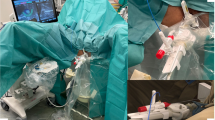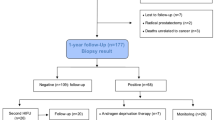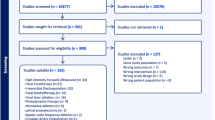Abstract
The objective of this study was to report on technical incidents and early and late complications occurring in high-intensity focused ultrasound (HIFU) treatment of patients with localized prostate cancer. We performed a retrospective review of patients who were treated by Ablatherm at our centre. We recorded all technical incidents, treatment discontinuations and early (<1 month) and late complications. A total of 74 HIFU procedures were performed in 65 patients (55 first-line HIFU treatments and 10 cases of salvage therapy after radiotherapy) over a 5-year period. Median follow-up was 41 months (10–64 months). All the procedures were well tolerated and no intra- or peri-operative deaths occurred. Six technical incidents in the overall population (8.1%) led to discontinuation of the procedure. The early complication rate in patients undergoing first-line HIFU was 36.4%: urinary retention (20%), dysuria (5.4%), urinary infection (3.6%), haematuria (3.6%) and urethral stenosis (3.6%). The late complication rate was 12.7%: urethral stenosis (9%) and dysuria (3.6%). There were no cases of rectourethral fistula. The long-term urinary incontinence rate was 20% and the de novo erectile dysfunction rate was 77.1%. Nine complications (16.4%) required surgical management. The overall complication rate was 49%. Ablatherm is a reliable technique with a relatively high complication rate. However, most complications were minor and required surgical management in a few cases only. Our results confirm that all patients who are offered HIFU treatment should be properly informed of the risks, in particular with regard to continence and sexual function.
This is a preview of subscription content, access via your institution
Access options
Subscribe to this journal
Receive 4 print issues and online access
$259.00 per year
only $64.75 per issue
Buy this article
- Purchase on Springer Link
- Instant access to full article PDF
Prices may be subject to local taxes which are calculated during checkout
Similar content being viewed by others
References
Thüroff S, Chaussy C, Vallancien G, Wieland W, Kiel HJ, Le Duc A et al. High-intensity focused ultrasound and localized prostate cancer: efficacity results from the European multicentric study. J Endourol 2003; 17: 673–677.
Blana A, Rogenhofer S, Ganzer R, Lunz JC, Schostak M, Wieland WF et al. Eight years’ experience with high-intensity focused ultrasonography for treatment of localized prostate cancer. J Urol 2008; 72: 1329–1334.
Poissonnier L, Chapelon JY, Rouvière O, Curiel L, Bouvier R, Martin X et al. Control of prostate cancer by transrectal HIFU in 227 patients. Eur Urol 2007; 51: 381–387.
Pasticier G, Chapet O, Badet L, Ardiet JM, Poissonnier L, Murat FJ et al. Salvage radiotherapy after high-intensity focused ultrasound for localized prostate cancer: early clinical results. Urology 2008; 72: 1305–1309.
Zacharakis E, Ahmed HU, Ishaq A, Scott R, Illing R, Freeman A et al. The feasibility and safety of high-intensity focused ultrasound as salvage therapy for recurrent prostate cancer following external beam radiotherapy. BJU Int 2008; 102: 786–792.
Challacombe BJ, Murphy DG, Zakri R, Cahill DJ . High-intensity focused ultrasound for localized prostate cancer: initial experience with a 2-years follow-up. BJU Int 2009; 104: 200–204.
Coulange C . High intensity focused ultrasound in localized prostate cancer. Cancer Radiother 2005; 9: 377–378.
Soulié M, Beuzeboc P, Cornud F, Eschwege P, Gaschignard N, Grosclaude P et al. Recommandations 2007 en onco-urologie. Prog Urol 2007; 17: 1157–1188.
Ingelman-Sundberg A . Urinary incontinence in women. Nord Med 1953; 50: 1751–1752.
Murat FJ, Poissonnier L, Rabilloud M, Belot A, Bouvier R, Rouviere O et al. Mid-term results demonstrate salvage high-intensity focused ultrasound (HIFU) as an effective and acceptably morbid salvage treatment option. Eur Urol 2008; 55: 640–649.
Chalasani V, Martinez CH, Lim D, Chin J . Salvage HIFU for recurrent prostate cancer after radiotherapy. Prostate Cancer Prostatic Dis 2009; 12: 124–129.
Colombel M, Gelet A . Principles and results of high-intensity focused ultrasound for localized prostate cancer. Prostate Cancer Prostatic Dis 2004; 7: 289–294.
Ahmed HU, Ishaq A, Zacharakis E, Shaw G, Illing R, Allen C et al. Rectal fistulae after salvage high-intensity focused ultrasound for recurrent prostate cancer after combined brachytherapy and external beam radiotherapy. BJU Int 2009; 103: 321–323.
Blana A, Murat FJ, Walter B, Thuroff S, Wieland WF, Chaussy C et al. First analysis of the long-term result with transrectal HIFU in patients with localized prostate cancer. Eur Urol 2008; 53: 1194–1201.
Lee HM, Hong JH, Choi HY . High-intensity focused ultrasound therapy for clinically localized prostate cancer. Prostate Cancer Prostatic Dis 2006; 9: 439–443.
Chaussy C, Thüroff S . The status of high-intensity focused ultrasound in the treatment of localized prostate cancer and the impact of a combined resection. Curr Urol Rep 2003; 4: 248–252.
Vallancien G, Prapotnich D, Cathelineau X, Baumert H, Rozet F . Transrectal focused ultrasound combined with transurethral resection of the prostate for the treatment of localized prostate cancer: feasibility study. J Urol 2004; 171: 2265–2267.
Blana A, Hierl J, Rogenhofer S, Lunz JC, Wieland WF, Walter B et al. Factors predicting for formation of bladder outlet obstruction after high-intensity focused ultrasound in treatment of localized prostate cancer. Urology 2008; 71: 863–867.
Blana A, Walter B, Rogenhofer S, Wieland WF . High-intensity focused ultrasound for the treatment of localized prostate cancer: 5-years experience. Urology 2004; 63: 297–300.
Uchida T, Ohkusa H, Yamashita H, Shoji S, Nagata Y, Hyodo T et al. Five years experience of transrectal high-intensity focused ultrasound using the Sonablate device in the treatment of localized prostate cancer. Int J Urol 2006; 13: 228–233.
Ficarra V, Antoniolli SZ, Novara G, Parisi A, Fracalanza S, Martignoni G et al. Short-term outcome after high-intensity focused ultrasound in the treatment of patients with high-risk prostate cancer. BJU Int 2006; 98: 1193–1198.
Poissonnier L, Gelet A, Chapelon JY, Bouvier R, Rouviere O, Pangaud C et al. Result of transrectal focused ultrasound for the treatment of localized prostate cancer (120 patients with PSA <or+10 ng/ml). Prog Urol 2003; 13: 60–72.
Murat FJ, Poissonnier MD, Pasticier G, Gelet A . High-intensity focused ultrasound (HIFU) for prostate cancer. Cancer Control 2007; 14: 244–249.
Rebillard X, Soulié M, Chartier-Kastler E, Davin JL, Mignard JP, Moreau JL et al. High-intensity focused ultrasound in prostate cancer: a systematic literature review of the French Association of Urology. BJU Int 2008; 101: 1205–1213.
Uchida T, Ohkusa H, Yasunori N, Hyodo T, Satoh T, Irie A . Treatment of localized prostate cancer using high-intensity focused ultrasound. BJU Int 2006; 97: 56–61.
Chaussy C, Thüroff S . Results and side effects of high-intensity focused ultrasound in localized prostate cancer. J Endourol 2001; 15: 437–440.
Chaussy C, Thüroff S . High-intensity focused ultrasound in prostate cancer: results after 3 years. Mol Urol 2000; 4: 179–182.
Blana A, Rogenhofer S, Ganzer R, Wild PJ, Wieland WF, Walter B . Morbidity associated with repeated transrectal high-intensity focused ultrasound treatment of localized prostate cancer. World J Urol 2006; 24: 585–590.
Chen L, Ter Haar HG, Hill CR . Influence of ablated tissue on the formation of high-intensity focused ultrasound lesions. Ultrasound Med Biol 1997; 6: 921–931.
Curiel L, Chavrier F, Gignoux B, Pichardo S, Chesnais S, Chapelon JY . Experimental evaluation of lesion prediction modelling in the presence of cavitation bubbles: intended for high-intensity focused ultrasound prostate treatment. Med Biol Eng Comput 2004; 42: 44–54.
Heidenreich A, Bolla M, Joniau S, van der Kwast TH, Matveev V, Mason MD et al. European Association of Urology–Guidelines on Prostate Cancer. 2009, p 72–73.
Tsakiris P, Thüroff S, de la Rosette J, Chaussy C . Transrectal high-intensity focused ultrasound devices: a critical appraisal of the available evidence. J Endourol 2008; 22: 221–229.
Author information
Authors and Affiliations
Corresponding author
Ethics declarations
Competing interests
The authors declare no conflict of interest.
Rights and permissions
About this article
Cite this article
Ripert, T., Azémar, MD., Ménard, J. et al. Transrectal high-intensity focused ultrasound (HIFU) treatment of localized prostate cancer: review of technical incidents and morbidity after 5 years of use. Prostate Cancer Prostatic Dis 13, 132–137 (2010). https://doi.org/10.1038/pcan.2009.57
Received:
Revised:
Accepted:
Published:
Issue Date:
DOI: https://doi.org/10.1038/pcan.2009.57



